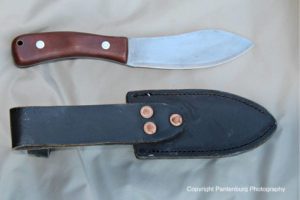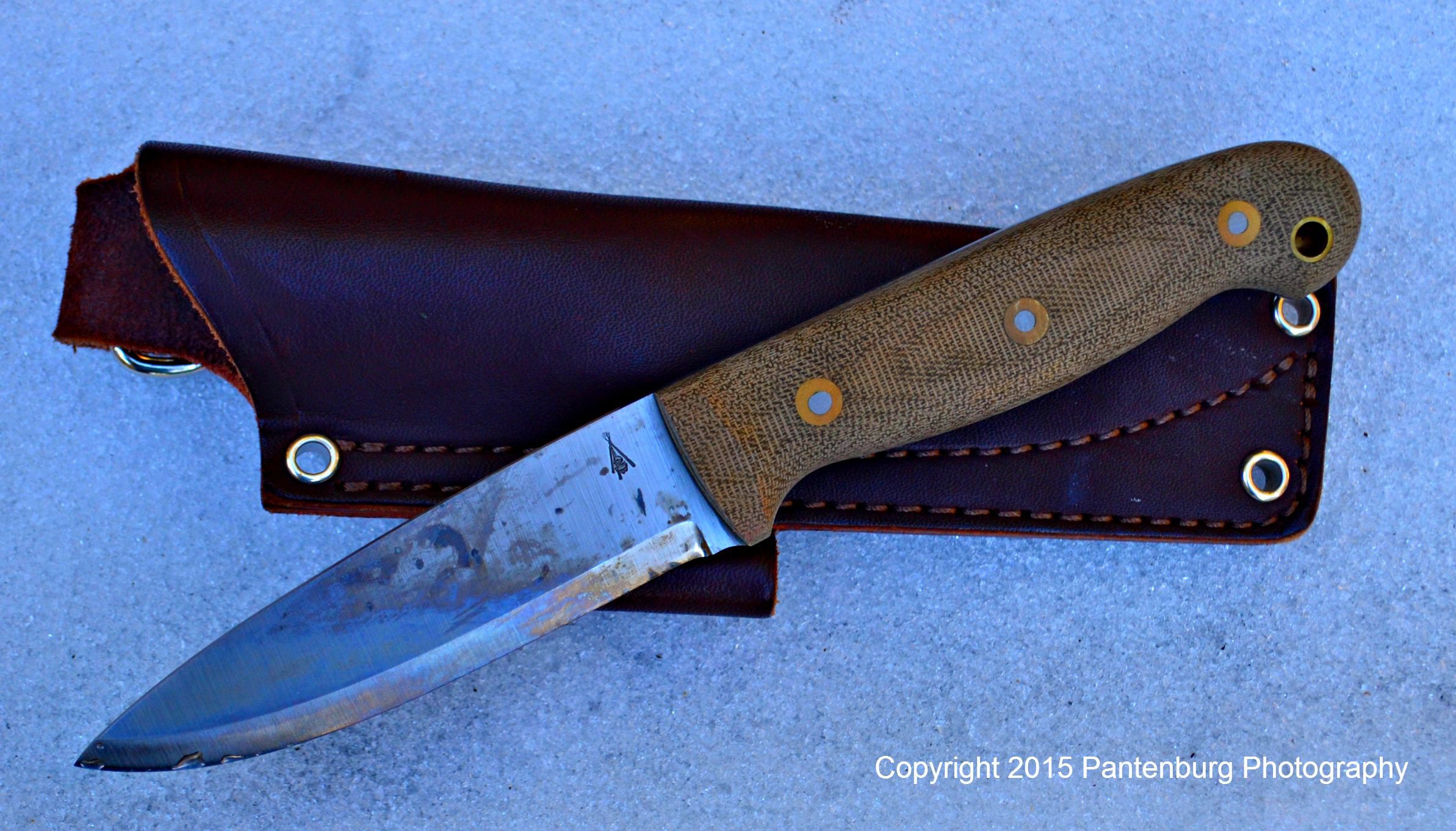Sometimes a knife just looks right, and that’s what drew my eye to an ad for a “Nessmuk” knife. It looked like a quality workhorse.

The C.T. Fischer Nessmuk knife comes shaving-sharp with a quality sheath. (Pantenburg photos)
by Leon Pantenburg
(This is my opinion after testing this product. I was not paid to do this review.)
For a little background here, George Washington Sears, 1821-1890, is better known by his pen name of “Nessmuk.” He wrote one of the first wilderness survival books, “Woodcraft,” in 1884 and was a regular contributor to “Forest and Stream Magazine.”
Sears had tuberculosis and the simple minimalist lifestyle in the wilderness, similar to that of Henry David Thoreau, appealed to him. Subsequently, Nessmuk wandered widely in various forests and wilderness areas, writing very popular stories for largely eastern audiences.

Nessmuk carried this combo in the outdoors.
Nessmuk understood the importance of cutlery. His tools consisted of a custom light axe, a fixed blade knife he designed and a quality two-blade folding pocketknife.
I carry a quality saw instead of Nessmuk’s axe and a Scandinavian Mora and a Swiss Army Classic to replace his folder. But we both agree on the value of a sturdy sheath knife. Nessmuk thought the sheath knife should be of the best quality, well suited for skinning and field dressing game, and could be used as an eating utensil.
So when I saw a Nessmuk-style knife advertised by C.T. Fischer Knives, based in Elk City, Idaho, I just had to try one out . I called knife maker Christopher T. Fischer and asked about his product line.
Fischer makes a variety of styles of knives, and the Nessmuk he sent me for testing is made out of a piece of used circular saw blade that formerly saw duty in a lumber mill. The knife is shaped by grinding, and he didn’t do any additional tempering.
“I look at this knife as functional (though not ideal) as a bush knife, as well as functional (though not ideal) as a kitchen knife, ” Fischer wrote. “Also, the shape is historical.”

The Nessmuk is basically a bull nose skinner. It works very well!
“When I started making the knife, I knew it wouldn’t be my personal favorite. But, it is a very simple knife to make; it is lightweight; it is sturdy (feel free to baton it); it can be used as a light chopper; it is carbon steel; unlike junky stainless, it takes a superb edge; a file will cut it, when major metal removal is needed; the blade should last for a lifetime of sharpening, without getting any more difficult to sharpen (as is the case with thick-spined knives); and it has a definite historical connection that is a WHOLE lot better than Bear Grylls!
“The final element that keeps these knives in production, is the customer feedback. People love them! So, the knife is profitable to produce, has a low price (for a handmade tool), and has a connection to good batch of backwoods common sense,” he added.
The knife arrived about a week after our initial conversation. It came out the box shaving-sharp, and the first thing that caught my eye was the quality workmanship. This particular knife has a walnut handle, and the pride in craftsmanship is immediately evident. The blade is about four inches long and the smooth, flowing lines of the design are pleasing to look at. The handle is ergonomically designed and fits my hand very well. It comes with a quality hand-sewn leather sheath.
But a pretty knife that doesn’t work well is nothing more than expensive eye candy junk, IMO, and I set out to test it. My standards for knife evaluation are based on use, not abuse. Try hard enough and you can break anything, and I’m not sure what that necessarily proves.
So essentially, all the knives I test start out in the kitchen. They are used at every opportunity, to evaluate how the blade works for different common tasks. Also, I’ll find some lengthy cutting job, such as slicing prime rib thin, to test the handle design. The Nessmuk went on a picnic where it was used to slice up three large tri-tips and several chickens, and it came through with flying colors.
Once a knife passes the kitchen test, it goes outdoors. I did baton (pound the knife through a piece of firewood to make kindling) with it, though, quite frankly, this test is not particularly indicative of blade quality. If you have the right technique and piece of wood, batoning can be done with just about any knife you can image.
Then I cut up a bunch of manila rope, carved the end of a hickory hammer handle and whittled a lot of kindling to start a fire.

The Nessmuk comes with a sturdy sheath.
The blade held its edge throughout all this work, so finally, I deliberately dulled it with a rock. It was no job at all to put the edge back on it, and a few swipes with my butchering steel returned it to shaving sharp. The blade comes with a Scandinavian bevel edge to it, so re-sharpening is easy, even for a beginner.
Here’s my thoughts on the Nessmuk after testing it:
The Nessmuk is not the best kitchen knife. While it slices and chops well and is easy to handle, it is too big for peeling potatoes, and it would be difficult to fillet fish with. It would work well for cutting the heads off small fish and gutting them, though!
And it would not be a perfect survival knife for me, because the blade is a little short (I like a five-to-six inch blade for overall use). My preference in this category remains the Cold Steel SRK, Bravo 1.25 LT or Ambush Tundra.
But the Nessmuk design may without peer for skinning large game animals. I typically use a Green River or Forshner five-inch sheep skinner for my elk and deer skinning chores that has been modified with a sharper point. For small game skinning, such as rabbits and squirrels, a good Mora or the Cold Steel Canadian Belt knife is my choice.
In essence, these are modified Nessmuk knives, and they have proven themselves many times over.
But here’s the final part of the Fischer Nessmuk test, and I hope to play out this scenario in October. (Note to Harrison Smith – This scenario did play out, though not in the mountains!)
The sound of the shot echoes through the timber and canyon, and the elk drops in its tracks. After making sure it won’t get up, I walk over, remembering to be thankful for where I am and what I am doing.
Then, the fun is over. I will pull out the Nessmuk from my day pack and get to the chore of skinning. I bet the knife will work superbly.
While the Nessmuk wouldn’t be my first choice as a survival or kitchen knife, in my hand, in that situation, it could prove to be my favorite knife!
For more information and to view the C.T. Fischer knives website, click here.
Please click here to check out and subscribe to the SurvivalCommonSense.com YouTube channel – thanks!





Leave a Reply